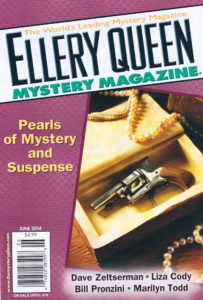How often? I just ran a search of my published stories, and here are the results:
- Asshole -- used in two stories (6% of all my published stories).
- Fuck -- used in two stories (6%). A surprisingly low number. I'll have to work on that.
- Shit -- used in four stories (12%).
- Bastard -- used in five stories (16%).
- Bitch -- used in fifteen stories (48%!). I might have to tone this one down.

Cunt. There I said it.
And I'm cringing.
There is just something about this word that, to me at least, crosses a line. I know some of you are reading this thinking I must have no lines. But I do. And cunt crosses it. That's why I never say it. And until now I've never used it in my fiction.
So why did I make this exception? And was it a good choice?
To answer these questions, let's turn to the story in question. It's my newest story, "Punching Bag," which was published last week in the Winter 2019 issue of Flash Bang Mysteries, an e-zine that showcases crime flash fiction. I'm delighted that not only did editors BJ and Brandon Bourg choose to publish it, but they also chose it as the cover story and as the editors' choice story for the issue. It's the story of the darkest day in an emotionally abused teenage girl's life.
Let's stop here for a moment. I'm afraid that anything I say from here on will ruin the story for you if you haven't read it. So please go do so. The story is only 748 words long--the equivalent of three double-spaced pages. You can read it really quickly by clicking on the title in the prior paragraph. Then come back.
Okay, you've read it? Good. (I hope you liked it.)
You'll notice that the use of curse words is minimal. Toward the end the mom says the daughter is stupid and calls her a "disappointing, ungrateful bitch," and other unspecified names. That was all I planned to say about the matter originally, figuring readers could extrapolate from there. But one of my trusted beta readers told me she didn't think the girl was justified in killing her parents. She thought the girl came across as spoiled and selfish. I was surprised. I definitely didn't want that. I wanted readers to understand this girl, to be on her side, despite that she does a horrible thing. So I felt I needed to up the ante. That's when I added the part about her mom calling her a "self-centered cunt."
I figured if anything in this story was going to turn readers' perception of this girl from spoiled to sort-of justified, it would be that. If the word cunt crosses a line for me, I hoped, it would cross a line for readers, too--at least any readers whose line hadn't already been crossed by the mom's behavior.
 So I submitted the story. But I worried. Was the use of the word cunt too much? Would it keep the story from being accepted? Then, once the story was accepted, I worried about readers. Would the word turn them off? Especially readers who know me primarily for my lighthearted, funny stories? The answer: So far, so good. I've gotten some feedback on "Punching Bag," and it's all been positive, with no one mentioning my use of that word. This response has helped me feel better about my choice, despite that the word still makes me cringe.
So I submitted the story. But I worried. Was the use of the word cunt too much? Would it keep the story from being accepted? Then, once the story was accepted, I worried about readers. Would the word turn them off? Especially readers who know me primarily for my lighthearted, funny stories? The answer: So far, so good. I've gotten some feedback on "Punching Bag," and it's all been positive, with no one mentioning my use of that word. This response has helped me feel better about my choice, despite that the word still makes me cringe.What do you think? Would you have been on the girl's side at the end if I hadn't included the "self-centered cunt" line? Or did the line push you onto the girl's side? Or do you think I went too far? What words cross your line?
One final note to my fellow SleuthSayer Robert Lopresti: Last week you wrote briefly about your newest flash short story (which is fewer than 700 words long), saying you were keeping things short because only English professors could get away with writing something about a story that is longer than the story itself. Ha ha, Rob! I have proven you wrong, because this blog about "Punching Bag" (excluding this paragraph) is 29 words longer than the story itself, and I am no English professor. Do I get a prize? Please don't make me become an English professor. I wouldn't last. I'd surely get written up for cursing in front of my students.






































